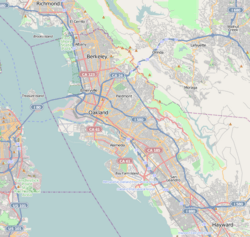Jingletown facts for kids
Quick facts for kids
Jingletown
|
|
|---|---|
| Country | United States |
| State | California |
| County | Alameda |
| City | Oakland |
| Neighborhood | Fruitvale |
| Elevation | 49 ft (15 m) |
| ZIP code |
94601
|
Jingletown is a unique neighborhood in Oakland, California. It's known as a special place for artists. The neighborhood is right next to the Oakland Estuary, which is a waterway. It's also close to Lake Merritt. Jingletown is part of a larger area in East Oakland called Fruitvale. Many artists live in buildings that used to be factories or warehouses, now changed into cool loft homes and studios.
Contents
How Jingletown Got Its Name
Jingletown's name comes from a fun story about the workers who lived there long ago. Many of these workers were men from Portugal, especially from the Azores islands. After a week of hard work at the nearby mills, they would walk home jingling the coins in their pockets. This was their way of showing they had earned their pay and were doing well.
Early History of the Area
Before it was called Jingletown, this area was part of a place known as San Antonio, Oakland, California. In 1851, a man named James Buskirk Larue bought land here. He built a store and a dock, and a small community grew around them. A train station was also built nearby.
Over time, the names of the area changed. Two early towns, Clinton and San Antonio, joined together in 1856 to form a new town called Brooklyn. This name came from a ship that brought settlers to California. Later, in 1872, the people of Brooklyn voted for their town to become part of Oakland.
From Orchards to Neighborhoods
The name Fruitvale (which used to be "Fruit Vale") comes from the many fruit orchards that grew here in the late 1800s. There were lots of apricot and cherry trees.
After the big 1906 San Francisco earthquake, many people who lost their homes in San Francisco moved to Oakland. This caused the population in Fruitvale to grow very quickly. By 1909, this growing neighborhood officially became part of the City of Oakland.
Changes in the Community
In the late 1950s and 1960s, many of the Portuguese families who had lived in Jingletown for a long time started to move out. At the same time, many Chicano and Latino families began moving into Jingletown. Some of these families had to move from other parts of Oakland because of city changes.
Jingletown played a part in the Chicano Movement during the late 1960s and early 1970s. This movement was about fighting for the rights and fair treatment of Mexican Americans. In 1970, a protest against the Vietnam war was organized in Jingletown by Chicano activists.
Jingletown Today: An Arts Community
In 1974, Jingletown faced a big challenge. There were plans for a large factory to expand, which could have meant tearing down parts of the neighborhood. But the people of Jingletown, including Chicano, Black, and Portuguese activists, worked together to stop these plans. They fought to keep their community from being destroyed.
As the 1970s ended, Jingletown went through some tough times. However, in 1998, the neighborhood started a big project to improve the area. New affordable housing was built, which helped to bring new life and energy to the community.
Today, Jingletown is one of the fastest-growing art districts in the San Francisco Bay area. It's a place where many artists live, work, and show their creations. An organization called the Jingletown Arts & Business Community (JABC) helps to support and represent the artists and businesses in the area.
See also


